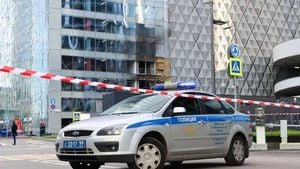Recent sinkhole phenomena across South Korea have raised alarm bells among citizens, with numerous incidents leading to casualties and property damage. The Ministry of Land, Infrastructure and Transport (MOLIT) reported on April 16, 2025, that they had identified 68 cavities with sinkhole risks in 94 high-risk areas following a thorough investigation conducted from October to December of the previous year. This investigation, which utilized ground penetrating radar (GPR) technology, revealed deteriorated water pipes and aging underground construction as significant factors contributing to these hazardous conditions.
One of the most alarming incidents occurred on March 24, 2025, when a massive sinkhole measuring 20 meters in diameter and 20 meters deep opened up in the heart of Gangdong-gu, Seoul, tragically resulting in the death of a motorcycle driver. This incident was not isolated; just last August, a car fell into a sinkhole in Yeonhui-dong, Seodaemun-gu, injuring the driver and two passengers. The sinkhole measured 6 meters in length, 4 meters in width, and 2.5 meters in depth.
According to MOLIT, a staggering total of 2,085 sinkholes occurred nationwide between 2014 and 2023. The highest number of incidents was reported in Gyeonggi Province, with 429 cases, followed by Gangwon with 270, Seoul with 216, Gwangju with 182, Chungbuk with 171, Busan with 157, and Daejeon with 130. These statistics highlight a growing trend that has left many citizens anxious about their safety.
In response to these incidents, local governments are taking measures to prevent future occurrences. Initiatives include the introduction of artificial intelligence (AI) equipment and expanding ground surveys. However, experts argue that these measures may not be sufficient to prevent accidents. Professor Lee Dong-gyu of Dong-A University's Disaster Management Department stated, "The recurrence of the same accidents indicates a greater underlying risk and emphasizes the need for civilian-led, proactive safety measures."
The Seoul Metropolitan Government has launched a 'Comprehensive Countermeasure for Ground Subsidence Prevention,' which encompasses expanding GPR surveys and replacing old water pipes. Additionally, they are developing 'Priority Improvement Areas' and 'Safety Maps' to better address the issue of sinkholes.
Jeju Island is also taking proactive steps by focusing on AI exploration equipment centered on port holes, while Ulsan is conducting thorough inspections through GPR surveys and borehole inspections, particularly on arterial roads. Meanwhile, Busan is expanding its GPR survey vehicles and enhancing real-time monitoring through automatic measurements during underground excavation work.
As part of these efforts, MOLIT announced that they would conduct another special inspection of large excavation construction sites from the end of April until May 2025. This inspection will involve the regional land management office confirming construction management adequacy at excavation sites, with the Korea Land and Geospatial Informatix Corporation conducting GPR investigations of nearby roads.
The need for these inspections has become increasingly urgent, especially after the tragic sinkhole incidents in Gangdong-gu and other regions. In September of last year, two trucks were trapped in a sinkhole measuring 10 meters in length, 5 meters in width, and 8 meters in depth in Sasang-gu, Busan. Such incidents have intensified public concern, leading to increased budget allocations for ground investigations and prevention measures. This year, the budget earmarked for ground investigations is approximately 14.56 billion won.
MOLIT has requested the Ministry of Economy and Finance to include expenses for purchasing investigation equipment and outsourcing tasks to the private sector in the supplementary budget. A MOLIT official noted, "It is easier to identify risks in advance if the ground investigation cycle is shortened," indicating that they are considering enhancing the investigation of high-risk areas from once every five years to twice a year.
Legal revisions are also being pursued to allow MOLIT to conduct on-site investigations directly in sinkhole-prone areas. On April 16, 2025, the National Assembly's Land, Infrastructure and Transport Committee's Land Law Review Subcommittee passed a revision to the 'Special Act on Underground Safety Management,' which would facilitate these measures. Currently, local government heads have the authority to conduct on-site investigations; however, interest levels vary significantly across different regions.
For instance, in the past five years, only five cities and provinces—Seoul, Busan, Gyeongbuk, Ulsan, and Gwangju—have conducted on-site investigations, revealing a concerning lack of proactive measures in other areas. MOLIT officials expressed hope that the new law, once passed, would enable systematic prevention management at the national level.
Despite these efforts, there are still significant challenges. Some local governments lack the necessary GPR equipment or are struggling to find qualified personnel to operate it. In North Jeolla Province, all 14 cities and counties lack GPR equipment entirely, while Chungbuk has low-cost GPR equipment but faces difficulties in securing professional staff to operate it.
As the number of sinkhole incidents continues to rise, the urgency of implementing effective preventive measures cannot be overstated. Local governments are under pressure to address the underlying issues that lead to sinkholes, such as deteriorating infrastructure and inadequate construction practices. With public safety at stake, the need for comprehensive, proactive measures is more critical than ever.





